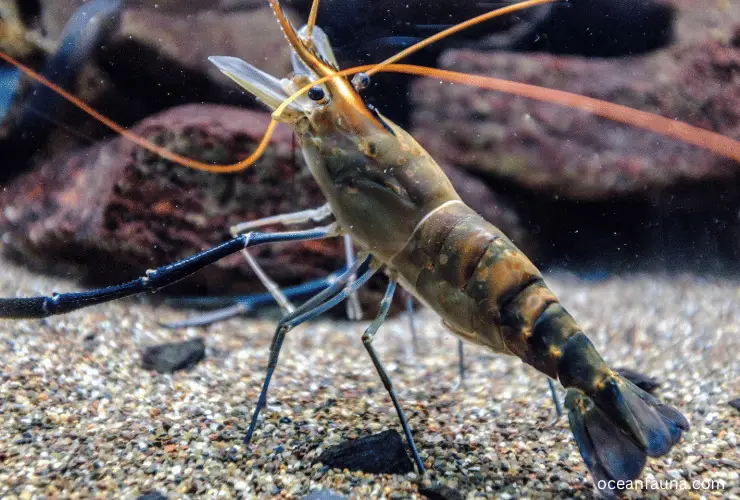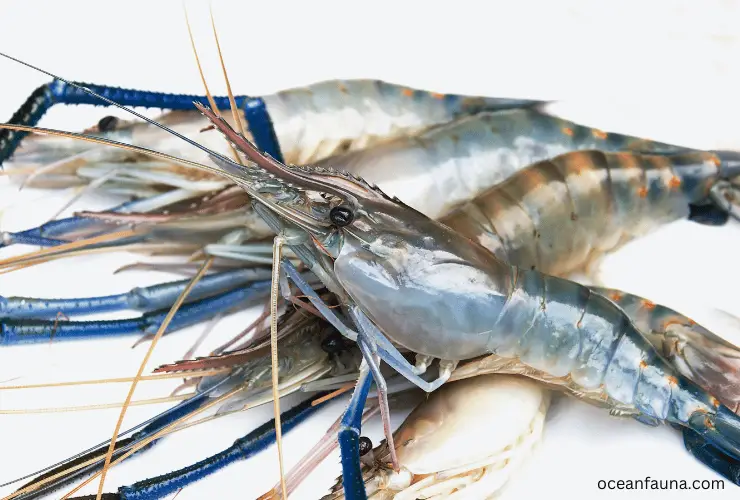Shrimps do have hearts, but their hearts are located in their heads and have a different structure than human hearts.
Shrimps also have an open circulatory system, meaning their organs are directly bathed in hemolymph, a fluid that carries out important bodily functions. This system is more efficient for aquatic animals, so shrimp hearts don’t need to be as powerful as human hearts.
This article will simplify the concepts of a shrimp’s circulatory system and the role of its heart to make it easier to understand.
Anatomy of Shrimp’s Heart
The anatomy of the shrimp’s heart is quite unique and intriguing. Unlike the human heart, which has two pairs of chambers, the shrimp’s heart is a compact single-chamber organ.

However, this doesn’t impede its functionality whatsoever. Instead, the shrimp has three heart entrances, known as Ostia. These openings are found in the heart’s walls and allow blood to flow in and out, circulating throughout the body.
This unique heart structure makes blood circulation in shrimps quite different from humans. The blood flows into the heart through the Ostia, where it then enters the chamber before being pumped out to circulate through the shrimp’s body. Interestingly, shrimp also have small ‘accessory hearts’ that help them circulate blood more efficiently throughout their body.
Despite the significant differences between the shrimp’s heart and the human heart, both organs serve the same purpose: to pump blood throughout the body.
However, the shrimp’s heart has adapted beautifully to its environment and specific needs, allowing these creatures to thrive in their underwater world.
How Many Hearts Do Shrimps Have?
Shrimps, like other arthropods, have a compact single-chamber heart. This means they have only one heart that pumps blood throughout their body. The shrimp heart is located in the shrimp’s head.
The shrimp heart is a small, muscular structure that is responsible for pumping hemolymph throughout the body of the shrimp. Hemolymph is a fluid similar to blood in vertebrates but does not contain red blood cells.
The shrimp heart has a unique structure that is different from other types of hearts. It is divided into three sections: the ostia, the ventricle, and the aorta.
The ostia are small openings or channels in the heart wall that allow hemolymph to enter the heart. The ventricle is the heart’s main pumping chamber, which pumps the hemolymph out of the heart and into the aorta. The aorta is a large blood vessel that carries hemolymph to different parts of the body.
What Is the Function of The Heart in a Shrimp?
The heart of a shrimp plays a crucial role in circulatory function. As mentioned earlier, shrimp have an open circulatory system, which means that their blood or hemolymph is not fully contained in vessels. The heart is a central hub for blood circulation throughout the shrimp’s body.

One of the key functions of the shrimp’s heart is to draw blood in through Ostia, or small holes located throughout the body. These ostia allow blood to enter the heart, which can be pumped to other body areas. This helps ensure that all of the shrimp’s tissues and organs receive the oxygen and nutrients necessary to function properly.
Another essential function of the shrimp’s heart is to regulate blood or hemolymph flow. The heart can adjust the rate at which blood is pumped out, depending on the needs of the shrimp’s body.
For example, during times of increased activity or stress, the heart may pump more blood to provide the necessary oxygen and nutrients to the shrimp’s muscles.
In addition to these primary functions, the shrimp’s heart also serves as a location for the removal of waste products from the body.
As blood circulates through the tissues, it picks up waste products such as carbon dioxide. These waste products are then transported back to the heart, where they can be removed from the body.
Where Is a Shrimp’s Heart Located?
The shrimp’s heart is located in the head portion of its exoskeleton, which contains its face and stomach. This is an unusual feature as most organisms have their hearts located in their chest or abdominal regions. The shrimp’s heart is a small, tubular structure that runs along the dorsal side of its body, pumping hemolymph throughout its circulatory system.
The shrimp’s heart is located in its head may seem odd, but it is a beneficial adaptation for this particular species.

Since shrimp are typically bottom-dwelling creatures, having their hearts closer to their heads allows for more efficient circulation of oxygenated blood to their brain and sensory organs. This allows them to respond quickly to changes in their environment, such as the presence of predators or prey.
It is worth noting that the shrimp’s circulatory system differs from that of vertebrates in several ways. For example, instead of blood, their circulatory fluid is called hemolymph, which does not contain red blood cells or hemoglobin.
Additionally, their hearts only have one chamber and are not as complex as those of mammals or birds. Despite these differences, the shrimp’s circulatory system is still able to effectively transport oxygen and nutrients throughout its body, thanks in part to the location of its heart in its head.
Do Shrimps Have an Open Circulatory System?
Yes, shrimps have an open circulatory system. This means that their blood, or hemolymph, flows freely through the body cavities rather than being contained within vessels.
A shrimp’s heart has three holes, called ostia, that draw in hemolymph and then pump it out to circulate through the shrimp’s tissues. The hemolymph then returns to the heart, re-entering through the Ostia to begin the cycle.
The advantage of an open circulatory system is that it allows nutrients and oxygen to be delivered directly to the tissues rather than passing through the walls of blood vessels.
Additionally, the hemolymph doubles as the shrimp’s immune system, as it contains various cells and proteins that help fight off pathogens and infections.
However, there are also drawbacks to an open circulatory system. Without the pressure created by a closed circulatory system, hemolymph moves more slowly and can make it more difficult for shrimps to regulate their body temperature. As a result, many species of shrimp are only found in certain temperature ranges.
Conclusion
You now understand that shrimps have a single-chambered heart located in their head. This heart pumps hemolymph through an open circulatory system, which allows them to transport oxygen and nutrients to its tissues and defend against pathogens. However, shrimps cannot regulate their body temperature like other animals with a closed circulatory system.
Let me know if you have any further queries regarding their heart. I will answer them as soon as possible.


2 thoughts on “Do Shrimps Have Hearts? [Why It’s in the Head?]”